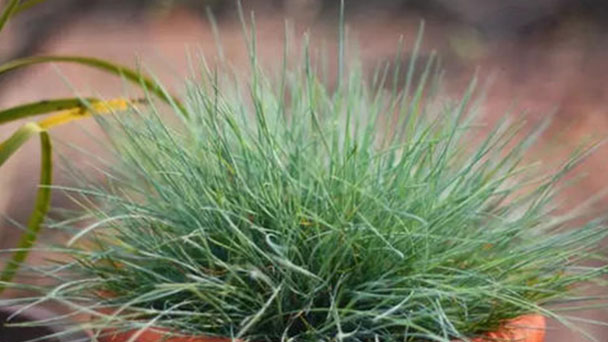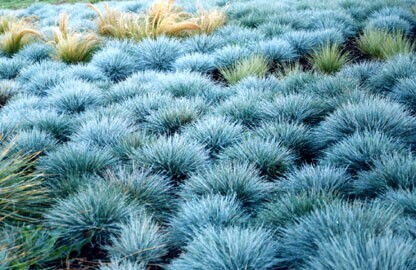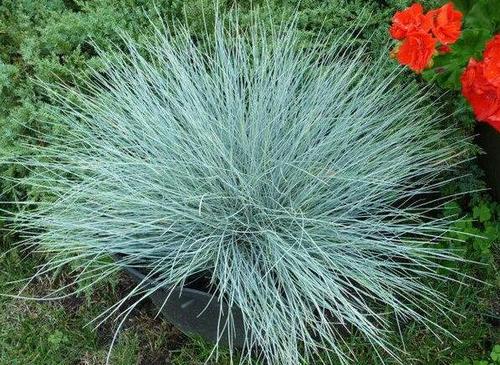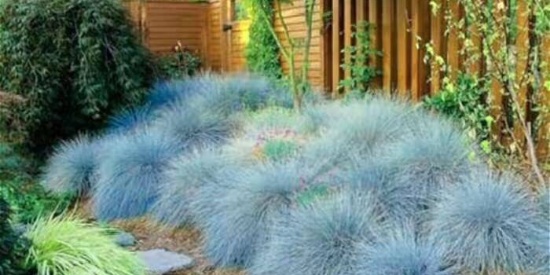Blue fescue (Festuca glauca) profile
Written by Maggie
Nov 05 2021

Blue fescue (Festuca glauca) is an evergreen herb of Gramineae Festuca, and it is of cold season type. Blue fescue plant height is about 40cm, plant diameter about 40cm. Leaves are erect smooth, strongly indenture a few acicular or hairy, bluish-green, silvery glaucous. It is blue in spring and autumn.
Blue fescue picture

Blue fescue info
| Botanical Name | Festuca glauca |
| Common Names | Blue fescue |
| Plant Type | Short-lived perennial grass |
| Sun | Full sun |
| Hardiness Zones | 4 to 8 (USDA) |
| Flower color | Greenish to yellow |
| Native Area | Center and southern Europe |
| Mature size | 9 to 12 inches in height, with a 6- to 9-inch spread |
Morphological characteristics of blue fescue
Strain
Blue fescue is an evergreen herb, cold season type. Clustering, plant height is about 40cm, plant diameter about 40cm.
Leaf
Blue fescue is erect smooth, leaf blade strongly coiled into a few needles or hairlike, blue-green, with silver glaucous. It is blue in spring and autumn.
Flowers
Panicles of Blue fescue, 10cm long, flowering in spring.
The ecological habits of blue fescue
Blue fescue likes light, cold, drought and infertility. Neutral or weakly acidic loose soils grow best and are slightly salt-tolerant. Full sunshine or partial shade good growth, avoid low-lying water. Cold to minus 35 degrees Celsius, should be properly watered during prolonged drought.
Species classification of blue fescue
The most famous Blue ornamental grass is the dwarf blue fescue (Festucaglauca), consisting of several species, the bluest of which is' Ellie 'Blue Blue fescue (F.G.' ElijahBlue '). This is a tufted evergreen cold-season ornamental grass with soft needle-like leaves that are silvery blue in summer and greener in winter. Its crown is twice the height of the plant, forming a round cushion about 30 cm high. (There is also a variety with a smaller cluster, but the larger one is the true 'Ellie' Blue fescue.) In late spring and early summer, it produces delicate panicles of the same color as the leaves, turning pale brown when it is firm. Some people like the contrast in color; those who don't cut the inflorescences.
Blue fescue is about 15cm to 23cm high at a young age, low, dense and cushion-like, and its crown width is equal to its height. But as the years go by, it gradually expands outward, and the center dies, leaving a blue ring that continues to grow outward, eventually forming individual clusters. To avoid this phenomenon, the plant should usually be dug up after 2 to 3 years for splitting. This also helps with color retention, as the blue of the plant is best displayed when it is young and vigorous.
Each species can be distinguished according to the shade of Blue and the height, such as the 'Mini' Blue Fescue (F.G. 'Minima'), which is only 10 cm high;' Blue fescue' (F.G. 'CAESIA') is similar to 'Ellie' Blue fescue, 30 cm tall but with finer leaves;' Blue fescue' (F.G. 'Azurit') is 30 cm high and tends to be Blue with less silver;'Harz' Blue fescue (F.G. 'Harz') presents a deep dark Blue, which can be used for the contrast of different shades of Blue; 'Milb' Blue fescue (F.G. 'Meerblau') has blue-green leaves and is growing strongly.
How to grow and care for blue fescue
Soil
Blue fescue is a kind of soil that is very resistant to poor soil and likes to grow on dry soil, so the drainage capacity of the soil must be strong. It is better to use weakly acidic soil, which will be more conducive to the growth of Blue fescue.Can use carbon ash, leaf rot soil, small stone mixed soil, not only dry drainage is better.
Water
Blue fescue does not have a high demand for water. If it is maintained outdoors, it can basically rely on the weather for food, and if it is kept indoors. After watering Blue fescue once, it can basically be spaced for a week. Of course, water mist can be sprayed more indoors to make its nutrition more balanced.
Fertilization
Blue fescue does not require very high fertilizer. Only in the peak growth season of Blue fescue, the growth can be guaranteed by applying a thin liquid fertilizer once a month. (Find more fall plants here.)
Illumination
Blue fescue is a kind of plant that loves light very much, so Blue fescue should be placed in a place facing the sunlight to receive the irradiation. During the growth period of Blue fescue, only after long-term exposure to light will the leaves become curly. In the absence of light, Blue fescue will grow straight.
Temperature
Blue fescue should be placed in a well-ventilated place for growth, which can effectively prevent diseases and insect pests. Blue fescue is suitable for growth at cool temperatures, and spring and autumn and winter are the seasons for its growth. Once the summer temperature is too high, it will enter the dormant period to stop growth, winter is too cold, of course, also want to move indoors, will inevitably be frozen to death.
Pruning
To maintain Blue fescue is simply to appreciate its leaves and unique appearance. If we want a beautiful appearance, we need to trim it by ourselves. Every spring and autumn, we need to prune Blue Fescue to remove excess branches and weak branches to maintain its perfect body shape.
Prevention of diseases and insect pests
Blue fescue is a very beautiful plant. At this time, people should pay attention to the prevention and control of diseases and insect pests of Blue fescue. Such as leaf spot disease, blight disease, aphids and harmful mites all pose threats to Blue fescue, so fungicides and insecticides should be selected to kill them for the first time!

Blue fescue propagation
Within a few years, blue fescue will begin to develop brown areas in the center of the clump, and will soon die away altogether unless lifted and divided. This plant rarely lives past three to five years unless it is divided.
Pry the dying plant up out of the ground with a shovel or a garden trowel.
Cut the clump in half, prying away the brown center portion of each smaller clump.
Replant the two new clumps as new plants, spacing them 8 to 10 inches apart.
The distribution area of blue fescue
Blue fescue is produced in Guangxi, Sichuan and Guizhou in China.
Landscape use of blue fescue
Blue fescue is suitable for the edge of flower beds and mirrors, and its prominent color can form a sharp contrast with flower beds and mirrors. It can also be used for the edge of the road. Potted plants, plantings or flowerbeds are excellent for edging.

Read Next:
Top 30 Fall Flowers to Plant - Beautiful Autumn Flowers
30 Fall Plants for a Beautiful Fall Garden
Latest Updated
- Benefits of Bugleweed - 7 Science-backed Health Benefits
- Bugleweed Dangers & Side Effects - Is It Poisonous?
- How to Plant Evergreen Trees - What You Should Know
- When to Plant Evergreens - Grow Guide for Evergreen Trees
- 12 Wonderful Evergreen Shrubs for Your Garden
- 12 Popular Evergreen Plants with Pictures for Beginners
- When And How To Prune A Lilac Bush Like a Pro
- How to Grow & Care for Lilac Vine (Hardenbergia Violacea)
- Japanese Lilac Tree (Syringa Reticulata) Care & Propagation Guide
- Shumard Oak Pros and Cons - What to Know
Popular Articles
- Winter maintenance of Antirrhinum Majus
- How to Grow Terminalia Mantaly Tree
- How to Grow and Care for Crossostephium Chinense
- How to grow Antirrhinum Majus in spring
- Peristeria Elata (Dove Orchid) Profile: Info & Care Guide
- Underwatered Snake Plant (Sansevieria Trifasciata) - Signs And How To Fix
- How to Care for Brazilian Jasmine Plant (Mandevilla Sanderi)
- How to Grow & Care for Graptopetalum Purple Delight in Summer
- Rosa Chinensis (China Rose): Plant Growing & Care Tips
- How to Care for Baby Sun Rose (Aptenia Cordifolia)